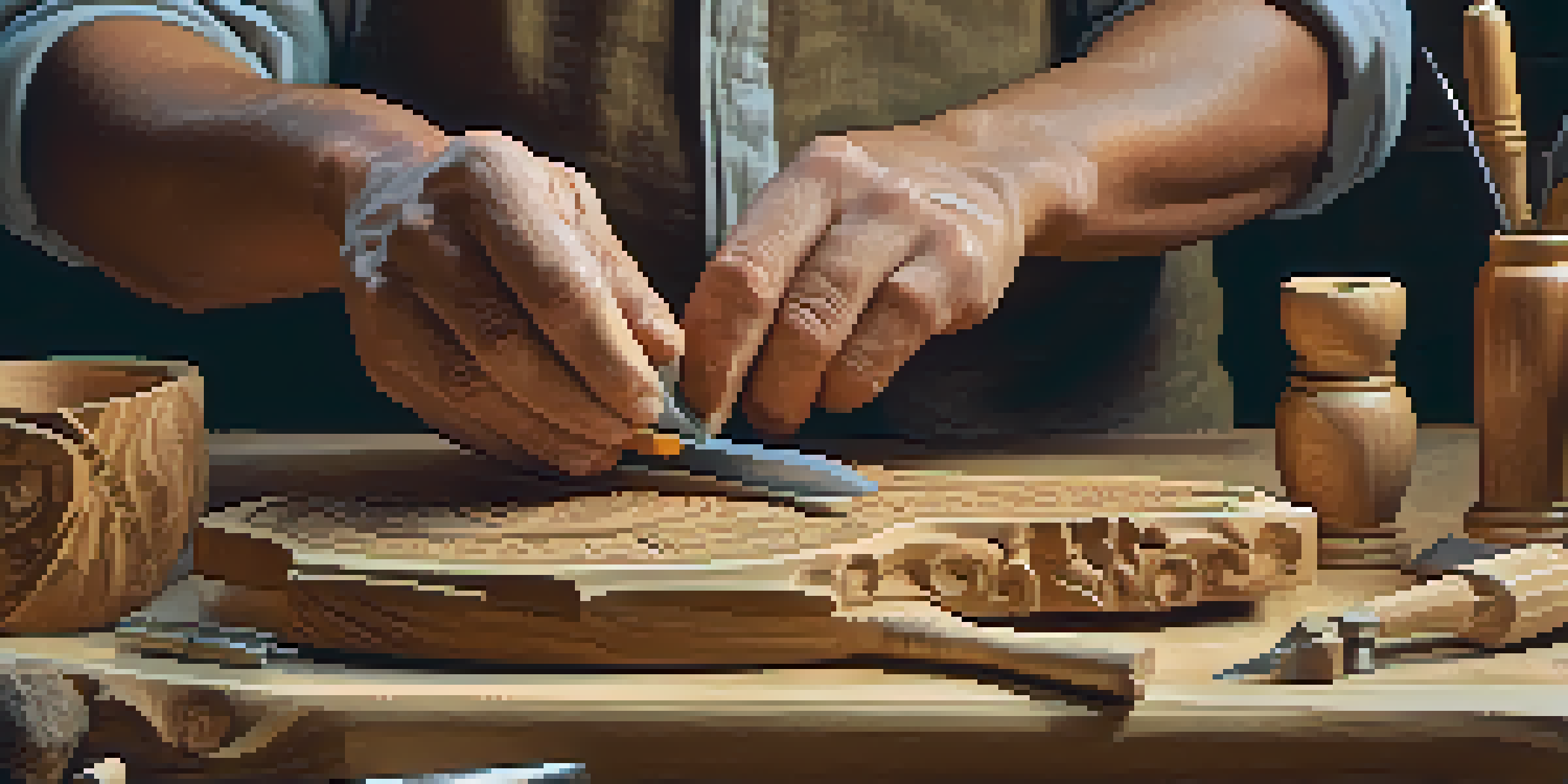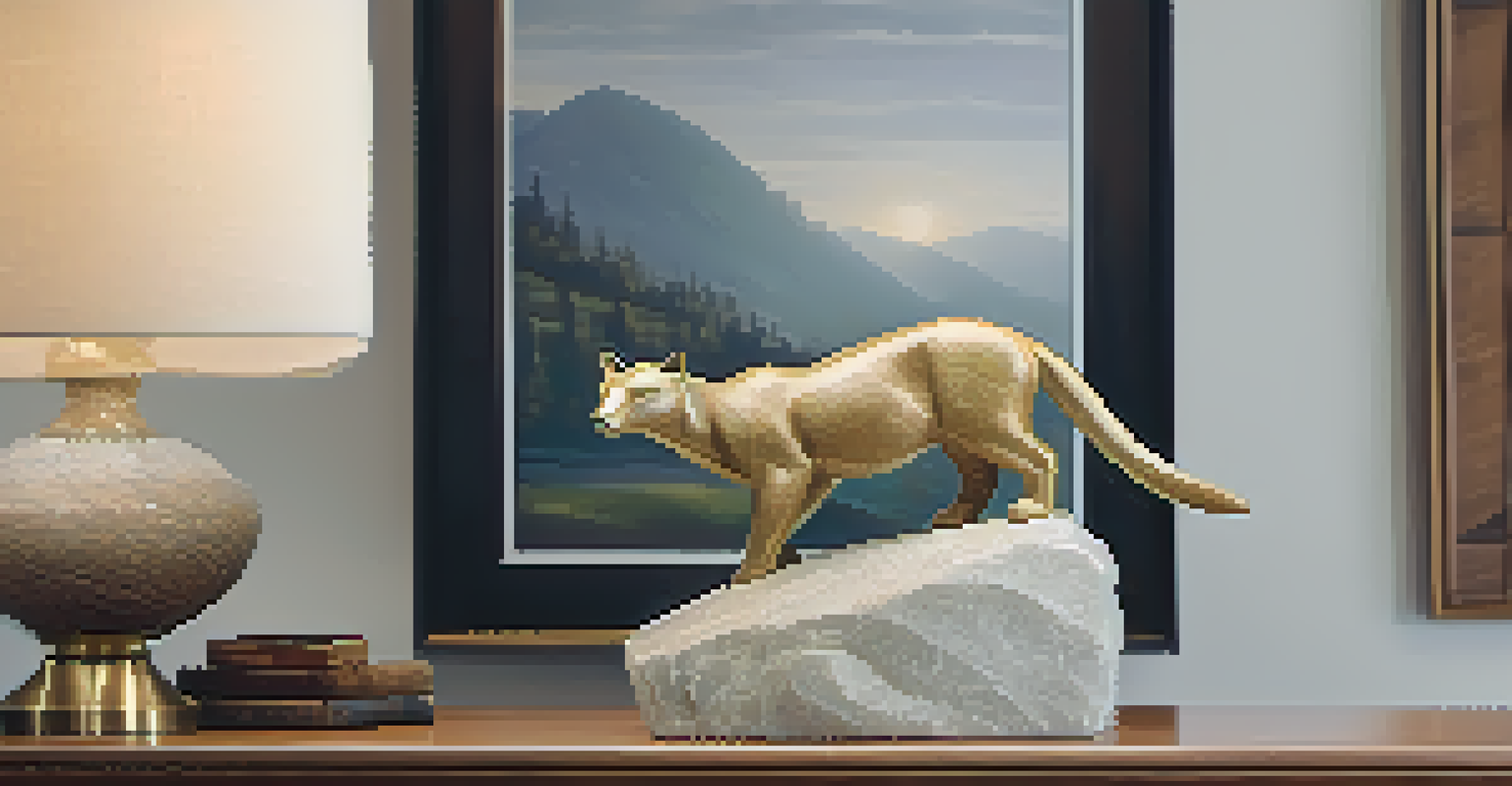Essential Tools for Carving Animal Figures in Wood and Stone

Understanding the Basics of Carving Tools
Before diving into the world of carving, it's essential to understand the different tools available. Carving tools can range from chisels to knives, each designed for specific tasks. Knowing the purpose of each tool helps you select the right one for your project, ensuring smoother and more efficient work.
The tools you use are the ones that will determine the quality of your work.
Wood and stone carving tools also vary significantly due to the materials' unique properties. For instance, softer woods might require different techniques than harder ones, just as soft stones like soapstone differ from harder materials like granite. Understanding these distinctions can save you time and effort.
Ultimately, investing time in learning about your tools will enhance your carving experience. Familiarity with how each tool functions will allow you to express your creativity more freely and achieve the desired results in your animal figures.
Essential Wood Carving Tools You Need
When it comes to wood carving, a few tools are indispensable. A set of quality carving knives is essential for creating detailed features, while gouges help hollow out areas more effectively. Each knife and gouge comes in various shapes and sizes, allowing for versatile carving techniques.

Additionally, a mallet is a great companion for driving your chisels and gouges into the wood without damaging them. It provides the necessary force while giving you control over the carving process. For finer details, consider adding a set of V-tools, which are perfect for intricate designs and patterns.
Essential Carving Tools Explained
Understanding the various carving tools and their specific uses is crucial for efficient and effective craftsmanship.
Lastly, always keep a sharpening tool handy. Sharp tools are safer and more efficient, making a noticeable difference in the quality of your carvings. Regular maintenance of your tools will ensure they serve you well for years to come.
Key Stone Carving Tools for Animal Figures
Stone carving requires a different set of tools, as the material is much harder than wood. A chisel set specifically designed for stone is essential, with various sizes to accommodate different carving needs. These chisels come in flat, pointed, and rounded shapes, each suitable for specific tasks.
Art is not what you see, but what you make others see.
Alongside chisels, a hammer or mallet is crucial for applying force to your chisels while carving. The right hammer can help you achieve precise strikes, which is vital when working with harder stones. Always choose a hammer that feels comfortable in your hand to maintain control.
Lastly, consider investing in a diamond blade saw for rough shaping your stone. This tool will allow you to remove larger sections of material before moving on to finer detail work. It’s an invaluable asset for anyone serious about stone carving.
Safety Gear: Protecting Yourself While Carving
Carving can be a fun and rewarding hobby, but safety should always be a priority. Wearing protective eyewear is crucial, especially when working with stone, as debris can fly unexpectedly. This simple step can prevent serious injuries and keep your focus on the art of carving.
In addition to eyewear, consider using gloves. While they provide grip and protect your hands from sharp tools, ensure they don’t compromise your dexterity. It's vital to find gloves that allow you to maintain control while offering some protection against minor cuts.
Safety First in Carving
Wearing protective gear such as eyewear and gloves is vital to ensure a safe carving experience.
Lastly, a dust mask is advisable when carving stone, as silica dust can be harmful when inhaled. Keeping a clean workspace and using proper ventilation will also contribute to a safer carving environment. Prioritizing safety ensures that you can enjoy your carving sessions without worry.
Techniques for Carving Animal Figures
Carving animal figures requires a mix of techniques that can vary between wood and stone. Starting with rough shapes using larger tools and gradually refining the details is a common approach. This method allows you to visualize the figure as you work, making adjustments along the way.
For wood, techniques like whittling and relief carving are popular. Whittling involves removing small pieces of wood to create shapes, while relief carving adds depth to a flat surface. Each technique offers unique opportunities for creativity and expression in your animal figures.
When working with stone, techniques like direct carving and point chiseling are often used. Direct carving allows you to shape the stone more freely, while point chiseling helps create more defined lines and details. Practicing these techniques will enhance your skills and lead to impressive results.
Choosing the Right Material for Your Carving
The choice of material can significantly impact the outcome of your carving project. For wood, popular options include basswood, pine, and cedar, each offering different textures and workability. Basswood, for example, is favored for its softness and fine grain, making it ideal for intricate designs.
When it comes to stone, you have a variety of options as well. Soapstone is often recommended for beginners due to its softness, making it easier to carve. On the other hand, harder stones like marble and granite provide a beautiful finish but require more advanced techniques and tools.
Choosing Materials Wisely
Selecting the right material for carving, whether wood or stone, significantly influences the outcome and ease of your project.
Ultimately, consider your skill level and the complexity of your design when selecting materials. Starting with softer materials can help build your confidence, while more challenging options can push your skills further as you gain experience.
Finishing Touches: Sealing and Displaying Your Work
Once you’ve completed your carving, the finishing touches are key to showcasing your work. For wood, sanding is essential to smooth out any rough edges and prepare the surface for sealing. A good finish not only enhances the appearance but also protects the wood from moisture and wear.
In contrast, stone carvings benefit from polishing to bring out the material's natural beauty. Using polishing compounds can help achieve a smooth, shiny surface that highlights the details of your animal figure. This step can truly transform your piece, making it stand out even more.

Finally, consider how you want to display your finished work. A well-chosen base or stand can elevate your carving from just an art piece to a focal point in your home. Whether it’s on a shelf or as a centerpiece, the way you present your work can make all the difference.